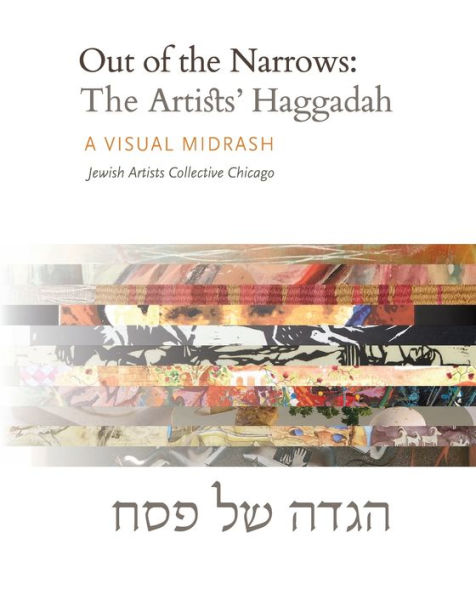Out of the Narrows: The Artists Haggadah was created during the modern plague of our time, Covid-19, which necessitated celebrating a socially distanced Passover. We created a text rich in meaning and beauty, one that would engage visually and thematically and evoke in-depth discussions at next year's Seder. Out of the Narrows is a complete Passover Haggadah with the Passover Seder in Hebrew, transliteration, and English, including all steps of the ceremony, rituals, prayers, liturgy, and commentary. It is also a Fine Arts book with art as commentary, featuring artwork by 11 members of Jewish Artist Collective Chicago (JACC)— a community of multidisciplinary artists connected through common heritage and committed to sharing ideas, enriching practices, and creating dialogue with community.
In the winter of 2019, we heard rumors about a contemporary plague, how a virus emerging from China began moving swiftly westward. Around Purim, it arrived on our shores full force, steamrolling communities, families, jobs, and businesses. Schools closed, shelter-in-place orders were issued, and masks, hand sanitizer, and gloves became precious commodities. And while the virus affected everyone, it tore through communities of color with breathtaking devastation, compounding the issues of social injustice the nation was already struggling with: family separations at the border, racism, police violence in the streets, extremist stirrings, and the doomsday clock of global warming inching ever forward. What a narrow and constricting place the world began to feel like. By the time Passover arrived in mid-April, the virus was in full force, so we commemorated our defining narrative COVID-19-style, and in the manner we are told the Israelites themselves did: each family alone, under the darkness of turmoil and threat. But if the Israelites performed their first acts of liberation and deliverance in darkness, behind doors swabbed with lamb's blood to throw off the Angel of Death, 2020 Jews in America and Europe lived politically and socially liberated lifestyles. Sheltering in place, we were still free to prepare more than the requisite unleavened bread as we sat down to our Seder tables. We could light candles and fill the Seder plate, prepare holiday foods, enact the fifteen steps. True, the pandemic disrupted the celebratory atmosphere: beloved faces in pixilated form popping up on screens could not replace the embraces we craved, the warmth of crowding a table to observe the holiday together. But like generations before us, we enacted the Seder regardless, opening our Haggadot and following instructions to wash and to break, to bless and to praise, to recite and to sing. We dipped twice and made Hillel Sandwiches, counted drops of wine to account for ten terrible plagues, asked questions and responded, and discussed freedom, slavery, and redemption. In effect, we told the story anyway, because that is what Passover demands of us: to tell the story to our children. And because everything about the Passover Seder is connected to a memory, enacting the Seder becomes a memory feast.
The Haggadah text requires us to ask questions. But the year that the world was undone by a virus, we asked even more. What does it mean to celebrate Passover in a pandemic? As artists, our job is to witness, comment, and create. How does art help make sense of the Passover story? How do its elements reflect on the plagues of disease, death, and injustice that still exist? How do we praise God when the world is broken and millions continue to suffer? But what is more diametrically opposed to the celebration of freedom and redemption–the becoming of who we are–than living in lockdown, figurative lamb's blood smearing the doors of the quarantined?



